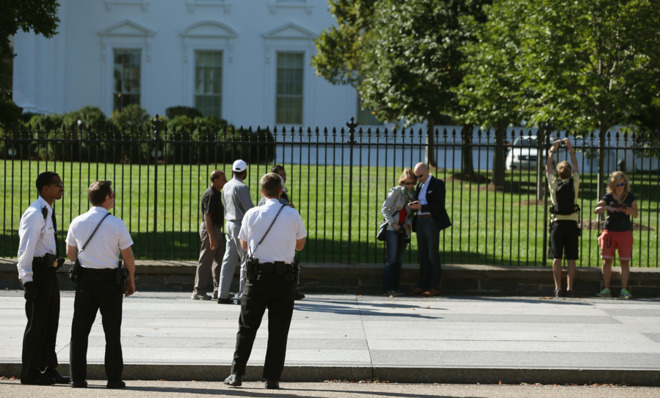7 questions for the Secret Service after the White House Security breach


When it comes to White House security, I'm an amateur. Though I've written quite a bit about the United States Secret Service, there's a lot I don't know about the complicated, multi-layered web of security procedures and protocols that compromise the White House Security Plan.
That said, you don't have to be an expert to know that the uproar over Friday's breach is understandable, and that the concern about Secret Service tactics is quite kosher. Some of the speculation about what should have been done, however, defies common sense. So let's roll through some of the questions — some good, some bad — that naturally arise in the wake of this breach.
1. Shouldn't someone have shot the guy? If there was a protectee in the residence at the time, maybe the mental calculus that governs such a decision would change. Put yourself in the mind of an officer who is 20 feet away from a guy who has no weapons in his hand and who is about to charge up the steps into an empty house. Then put yourself in the mind of an officer who is 20 feet away from a guy who has no weapons in his hand and who is about to charge up the steps into a house where the president of the United States and his family are resting on the second floor. The response is supposed to be the same, but in reality it won't ever be, and that's good here, because the guy, obviously suffering greatly, is alive and can get treatment while he serves his jail time. Officers have fired weapons several times in the past; in each case, the assailant was armed and an obvious threat to those around him.
The Week
Escape your echo chamber. Get the facts behind the news, plus analysis from multiple perspectives.

Sign up for The Week's Free Newsletters
From our morning news briefing to a weekly Good News Newsletter, get the best of The Week delivered directly to your inbox.
From our morning news briefing to a weekly Good News Newsletter, get the best of The Week delivered directly to your inbox.
Maybe anyone who manages, for whatever reason, to get by the Emergency Response Team (ERT) and their dogs should be a candidate for the use of deadly force. But shooting dead a person armed with a pocket-knife on the North Portico of the White House when no one's home? The much more reasonable question is, why didn't the ERT or an officer use non-lethal weapons to stop him before he reached the doors to the residence? That level of force is proportionate to the threat.
2. Why didn't they unleash the dog? The Uniformed Division's incredibly intelligent Malinois shepherds are trained to tackle people who are in motion. At the moment its handler could have released the dog, there were a half dozen Uniformed Division officers running toward the assailant. We might find out that the team was not deployed in a fashion that would have allowed the dog to focus only on one target — a target running towards him — and instead, was too far away to pick up his approach. When the dogs have been deployed to tackle fence-jumpers who run up the North Lawn, they get the guy every time. In this case, the handler might also have intuitively reasoned that since no one was in building, it might have been a bad idea to sick the dog on a fellow officer.
3. How come officers didn't leave their posts to join the chase? A few did, but most didn't, at least according to the video and press reports. Why? Security 101. Maybe the fence-jumper is a diversion; maybe the real attack is what comes next after resources are deployed.
But there are better questions, too, like:
A free daily email with the biggest news stories of the day – and the best features from TheWeek.com
4. Why wasn't the door locked? I assume it's very easy to quickly lock the doors to the residence by pushing a button. Why wasn't that button pushed the moment the radio squawked with news of the fence-jumper?
5. Are the radio procedures clear enough? Was the location of the fence-jumper conveyed to officers who couldn't yet see him but who could have been in a position to stop him if they encountered him and knew he was coming?
6. Did officers assume that the ERT team would take care of the threat (as they usually do) and not follow scenario-based training?
7. Do we want Secret Service officers to be more aggressive about confronting people who look or seem out of place outside the hard perimeter (the actual White House campus) but inside the soft perimeter (the streets and parks that surround it)? If you've ever been to the White House, you know it's a mecca for protesters, groups of weirdly dressed citizens, the homeless, and people who simply stand and gawk. And it's kind of cool and freeing that the White House can still be a gathering place for all sorts of people to do all sorts of things they're free to do. Nonetheless, Congress, the public, and the president want answers here.
It might be worth waiting until the investigation has ended before hauling the director, Julia Pierson, to Congress, for a public spanking. If lawmakers are really concerned about the security of the White House, the House's main government oversight committee should hold a closed hearing, because it's hard to imagine that there's any facet of the security plan that isn't law-enforcement sensitive or classified.
And indeed, there is a hearing scheduled for next week, while the press coverage is fresh.
Marc Ambinder is TheWeek.com's editor-at-large. He is the author, with D.B. Grady, of The Command and Deep State: Inside the Government Secrecy Industry. Marc is also a contributing editor for The Atlantic and GQ. Formerly, he served as White House correspondent for National Journal, chief political consultant for CBS News, and politics editor at The Atlantic. Marc is a 2001 graduate of Harvard. He is married to Michael Park, a corporate strategy consultant, and lives in Los Angeles.
-
 Metaverse: Zuckerberg quits his virtual obsession
Metaverse: Zuckerberg quits his virtual obsessionFeature The tech mogul’s vision for virtual worlds inhabited by millions of users was clearly a flop
-
 Frank Gehry: the architect who made buildings flow like water
Frank Gehry: the architect who made buildings flow like waterFeature The revered building master died at the age of 96
-
 Is MAGA melting down?
Is MAGA melting down?Today's Big Question Candace Owens, Tucker Carlson, Laura Loomer and more are feuding
-
 How Bulgaria’s government fell amid mass protests
How Bulgaria’s government fell amid mass protestsThe Explainer The country’s prime minister resigned as part of the fallout
-
 Femicide: Italy’s newest crime
Femicide: Italy’s newest crimeThe Explainer Landmark law to criminalise murder of a woman as an ‘act of hatred’ or ‘subjugation’ but critics say Italy is still deeply patriarchal
-
 Brazil’s Bolsonaro behind bars after appeals run out
Brazil’s Bolsonaro behind bars after appeals run outSpeed Read He will serve 27 years in prison
-
 Americans traveling abroad face renewed criticism in the Trump era
Americans traveling abroad face renewed criticism in the Trump eraThe Explainer Some of Trump’s behavior has Americans being questioned
-
 Nigeria confused by Trump invasion threat
Nigeria confused by Trump invasion threatSpeed Read Trump has claimed the country is persecuting Christians
-
 Sanae Takaichi: Japan’s Iron Lady set to be the country’s first woman prime minister
Sanae Takaichi: Japan’s Iron Lady set to be the country’s first woman prime ministerIn the Spotlight Takaichi is a member of Japan’s conservative, nationalist Liberal Democratic Party
-
 Russia is ‘helping China’ prepare for an invasion of Taiwan
Russia is ‘helping China’ prepare for an invasion of TaiwanIn the Spotlight Russia is reportedly allowing China access to military training
-
 Interpol arrests hundreds in Africa-wide sextortion crackdown
Interpol arrests hundreds in Africa-wide sextortion crackdownIN THE SPOTLIGHT A series of stings disrupts major cybercrime operations as law enforcement estimates millions in losses from schemes designed to prey on lonely users
